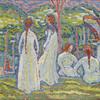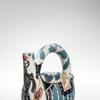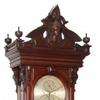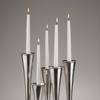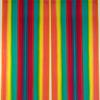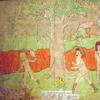SpaceX Has Blasted Artists' Projects Into Orbit
- December 03, 2018 13:35
Space is the new place for art. After flight delays, two museum-supported artist projects head into the final frontier.
On Monday morning, SpaceX successfully launched 2 artist projects into space onboard a re-used Falcon 9 rocket. Taking off from the California coast, these art pieces were ridesharing with 64 satellites sent up for commercial, government, and institutional entities, the largest payload ever launched from a U.S. space rocket.
Later on, SpaceX will confirm whether the art has made it into their own orbits.
Artist and MacArthur Genius grant fellow Trevor Paglen, with the Nevada Museum of Art, launched “Orbital Reflector" - an inflatable, 100-foot long space sculpture that should be visible with the naked eye from Earth. It will be in a low orbit for a couple months, and then burn up as it re-enters the atmosphere.
The $1.5 million art piece was packed inside a CubeSat to unfurl in space.
Describing "Orbital Reflector" as "aerospace engineering," Paglen, who is known for works that comment on mass surveillance, also writes on orbitalreflector.com: “When we look up into the starry night sky, we tend to see reflections of ourselves.” The ray-catching, diamond-shaped piece will be orbiting from about 350 miles above Earth.
ENOCH, supported by LACMA, was another artist-conceived piece onboard Spaceflight’s SSO-A: SmallSat Express mission from Vandenberg Air Force Base in Santa Barbara County. (View exciting footage of the launch here.)
LACMA Art + Technology Lab (SpaceX is a sponsor) grant recipient Tavares Strachan was behind the 3U satellite that brings to light the forgotten story of Robert Henry Lawrence Jr., the first African American astronaut selected for any national space program. He died in a tragic training accident in 1967.
To honor the astronaut’s legacy, ENOCH will orbit for seven years in the form of a 24-karat gold canopic jar with a bust of Lawrence. The canopic jar nods to a practice employed by the ancient Egyptians to protect and preserve organs of the deceased for use in the afterlife. The canopic jar was blessed at a Shinto shrine in Fukuoka, Japan, and was recognized as a container for Lawrence’s soul.
Named in the ritual blessing as “Robert Lawrence – Enoch” the object incorporates three religious traditions, all of which center on the agency of objects and the potential of a person’s spirit to endure. The name Enoch refers to a biblical figure (present in Jewish, Christian, and Muslim sacred texts) who never experienced mortal death, instead ascending directly into the afterlife. Strachan’s work integrates ancient belief systems with our current faith in technological progress—while rendering that progress inseparable from the efforts of the unrecognized lives that built our contemporary world.









